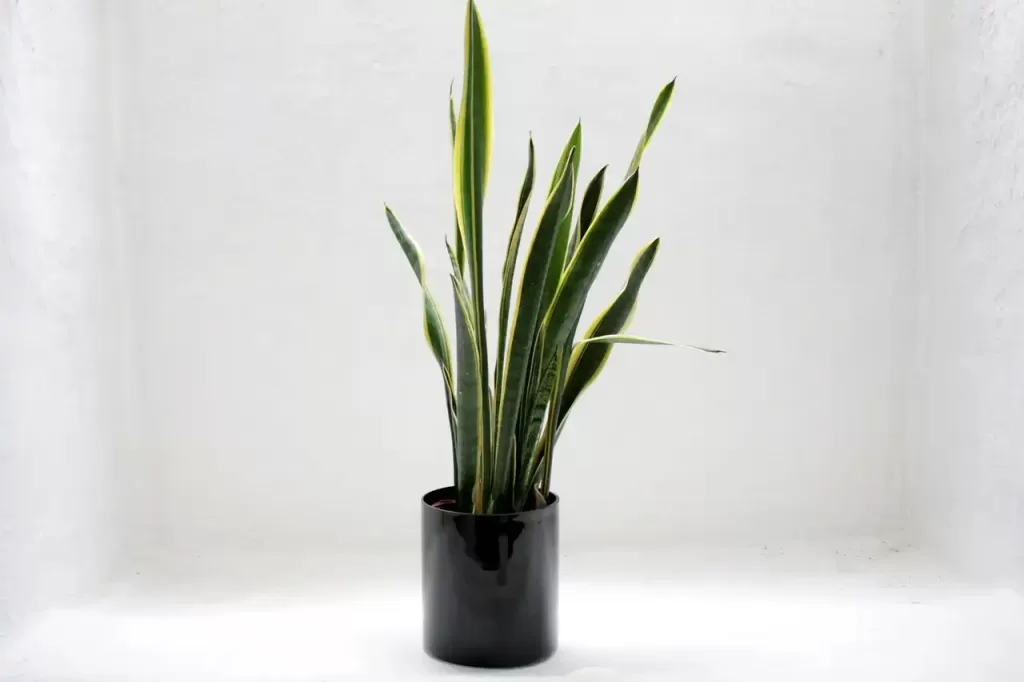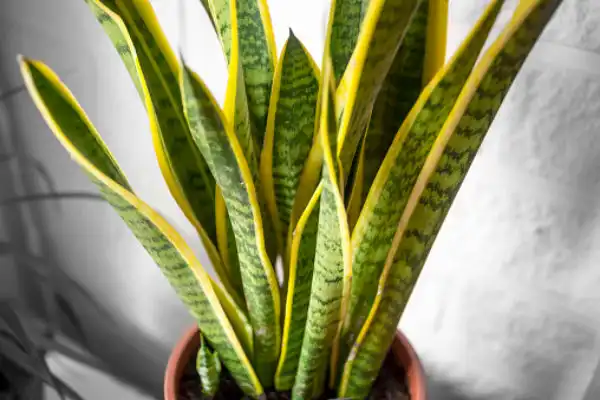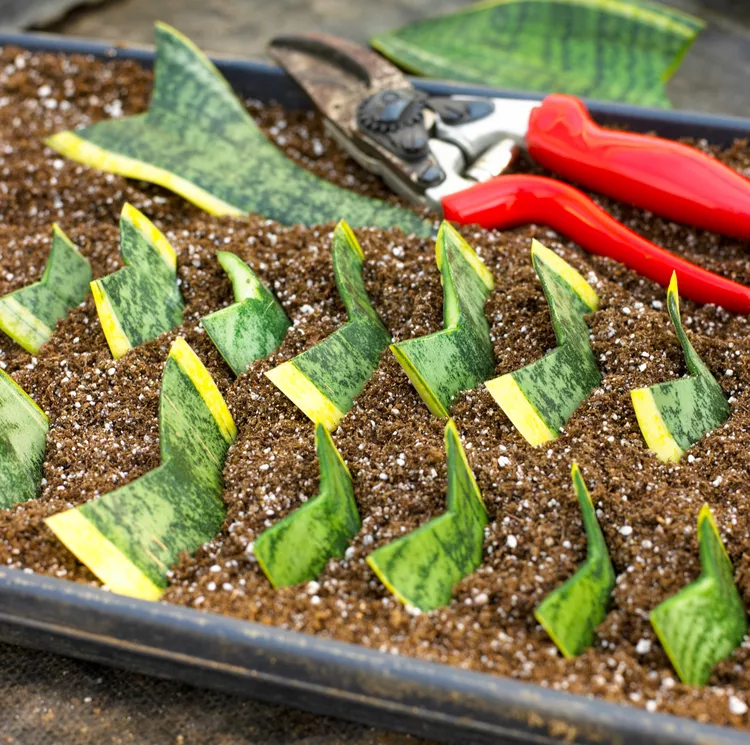
The plant Dracaena Trifasciata which is commonly known as Snake Plant belongs to the family Asparagaceae, monocot angiosperm plants. This plant is usually found in regions of West Africa and countries like Congo and Nigeria.
This plant is known to us by several common names such as Saint George’s Sword, Viper’s Bowstring Hemp, and most interestingly it is also called Mother-in-Law’s Tongue.
It is an evergreen flowering perennial plant having a land-creeping root-like structure called a rhizome. Just because it got sharp margins over erectly growing leaves it is given the name of the sword[1]Torres, K.C., In Vitro Propagation of Snake Plant (Sansevieria), in Tissue Culture Techniques for Horticultural Crops. 1989, Springer. p. 92-95..
The specialty of the snake plant is its photosynthesis at night times when all the other plants are releasing CO2 this releases O2. Its stomata are closed in the daytime to avoid and escape from transpirational water loss and open at night.

This is typically an outdoor ornamental plant in the hot summer season and can also be used as an indoor ornamental plant when the climate is relatively cooler[2]Heywood, V.H., et al., Flowering plant families of the world. Vol. 88. 2007: Firefly Books Ontario..
Types of Snake Plant
- The species with quite short leaves as compared to others with yellowish margins is known as Golden Hahnii.
- A cylindrical-shaped plant with exceptionally round leaves having dark green. Its leaves can have a maximum height of 3 to 4 feet.
- Some cultivars have some sort of twists in their leaves. The twisted has yellow variegations and these twisted species have a height of less than 1.5 feet.
- Some botanists have patented a wild type of snake plant with white and vertical variegation. This type has yellow sharp-margin leaves.
- There is a smaller type with leaves having red-tinted areas that can grow about 1 feet [3]Walters, M., DRACAENACEAE Salisb..
Snake Plant Propagation
1. Propagation by Leaf Cutting
This method is usually used to root snake plants in water. For this purpose, you need to take a healthy leaf of a snake plant and a sharp plant cutting knife or sharp shears to cut that young, healthy, and clean plant leaf.
After a clean and quick V shape cutting of that certain leaf put its cutting edge into clear water in such a way that the lower one-third part of the leaves is dipped into that water.
When you will use a transparent glass container you will be able to see the growing little root below the end in a few days. This technique of cutting plant leaves has its pros in growing new plants in water.

This method takes much time to make its roots well-grown for doing soil plantation. For achieving healthy a quick growth by the former method we need such soil having proper drainage. Because leaves can rot in more wet soil.
So we need to be careful about the moisture content of the pot when we have planted leaf cutting of snake plant[4]Sarmast, M., M. Salehi, and H. Salehi, The potential of different parts of Sansevieria trifasciata L. leaf for meristemoids production. Aust J Basic Appl Sci, 2009. 3: p. 2506-2509..
Read: Snake plant turning yellow? 6 Reasons and Solutions
2. Propagation by Root Clump Cutting
For this method of propagation, a healthy plant with a properly grown rhizome, the thick soil organ, is to be selected. Uproot the plant with great care and gently without breaking it.
Cut the rhizome having root clumps with sharp shears and scissors and place it in wet soil and in an area receiving good sunlight[5]Hematharshini, A. and T. Seran, IN VITRO SHOOT ORGANOGEN trifasciata L.) AS INFLUENCED B SUCROSE CONCENTRATION..
Proper mineralized and moist soil with sunlight can trigger fast regrowth of root clumps into new rhizomes and plants.
This can be helpful in creating a large number of relatively quick-growing plants in bulk. A good-sized plant with a large root clump is to be used for this propagation method[6]Sarmast, M.K., H. Salehi, and M. Khosh-Khui, Seismomorphogenesis: a novel approach to acclimatization of tissue culture regenerated plants. 3 Biotech, 2014. 4(6): p. 599-604..
This process is also important because it helps to keep the parental variegation intact[7]Joyner, J.F., E.O. Gangstad, and C.C. Seale, The Vegetative Propagation of Sansevieria 1. Agronomy Journal, 1951. 43(3): p. 128-130..
Read: Snake Plant Secrets: Mastering the Art of Watering
3. Micropropagation of Snake Plant
The above-mentioned procedures are slow and less efficient for mass production concerns. The technique of micropropagation is an emerging and advancing process by which we can enhance the speed of propagation as well as the number of plants per propagation process.
In-vitro preparation of snake plant organoids called meristemoids are grown on Petri-plates having artificially prepared culture medium for at least 15 to 21 days[8]Kaur, J. and G. MUDGAL, An Efficient And Quick Protocol For In Vitro Multiplication Of Snake Plant, Sansevieria Trifasciata Var. Laurentii [Prain]. 2021..
Medium is designed in such a way that supports root development first. When the roots are developed medium for shoot growth promotion is given to that meristemoid and thus roots are developed[9]Tchegnitegni, B.T., et al., A dihydrochalcone derivative and further steroidal saponins from Sansevieria trifasciata Prain. Zeitschrift für Naturforschung C, 2017. 72(11-12): p. 477-482..
Benefits of Snake Plant
- It is an ornamental evergreen plant for your house and office with attractive and beautiful colors and sharp erected shapes.
- It requires less care as compared to other indoor and outdoor plants.
- The snake plant is climate-friendly and can also be grown in cold areas or temperate regions as well as in warm countries.
- Snake plant cleans the air from organic chemical fumes such as benzene and other derivatives.
- It keeps the house well-aerated and provides it with fresh oxygen even at night times as well.
- It is easy to propagate and handle. Many medicinal compounds and fibers have been extracted for human and animal use[10]Knight, A.P. and R.G. Walter, A guide to plant poisoning of animals in North America. A guide to plant poisoning of animals in North America., 2002..
Read More Snake Plant Benefits

Care of Snake Plant
This is the easiest to take care of the Snake Plant. All you need to do is to add a liquid fertilizer after a gap of 6 months, as it can survive with less nutrition. This plant only requires dim or low-grade sunlight to grow. Snake plant usually grows well in warm climate conditions.
It can even survive with the least water in the pot because nature has given this plant the ability to avoid transpirational losses by keeping its stomata close during the daytime.
Snake plant also can bear high temperatures of about 55o-80o Celsius[11]Van Jaarsveld, E.J., Dracaena transvaalensis Bak.,(Dracaenaceae) the dragon tree of the Limpopo Province, South Africa. Bradley, 2016. 2016(34): p. 230-236..
Harms of Snake Plant
This is to be taken into account that this plant can be damaging to the stomach if accidentally ingested by humans or their pets[12]Bertero, A., et al., Plants, and zootoxins: Toxico-epidemiological investigation in domestic animals. Toxicon, 2021. 196: p. 25-31..
Pets specifically cats and dogs when coming in contact with this plant or ingesting any part of it then there is a chance of allergic irritations and even vomiting can be triggered.

A toxin named saponins is produced by the snake plant. If the leaves or part of the leaf is ingested, can cause gastrointestinal irritation in pet dogs and cats as well. Diarrhea, stomach ache, nausea, and extensive vomiting are key symptoms of ingesting this plant.
Read: Surprising Drawbacks of Snake Plants
These chemical saponins act as self-defense of snake plants against insects and fungi because saponins act as a natural insecticide as well as a fungicide. Swelling of the esophagus is also observed related to the intoxication of saponins[13]Knight, A., A guide to poisonous house and garden plants. 2019: Teton NewMedia..
References
| ↑1 | Torres, K.C., In Vitro Propagation of Snake Plant (Sansevieria), in Tissue Culture Techniques for Horticultural Crops. 1989, Springer. p. 92-95. |
|---|---|
| ↑2 | Heywood, V.H., et al., Flowering plant families of the world. Vol. 88. 2007: Firefly Books Ontario. |
| ↑3 | Walters, M., DRACAENACEAE Salisb. |
| ↑4 | Sarmast, M., M. Salehi, and H. Salehi, The potential of different parts of Sansevieria trifasciata L. leaf for meristemoids production. Aust J Basic Appl Sci, 2009. 3: p. 2506-2509. |
| ↑5 | Hematharshini, A. and T. Seran, IN VITRO SHOOT ORGANOGEN trifasciata L.) AS INFLUENCED B SUCROSE CONCENTRATION. |
| ↑6 | Sarmast, M.K., H. Salehi, and M. Khosh-Khui, Seismomorphogenesis: a novel approach to acclimatization of tissue culture regenerated plants. 3 Biotech, 2014. 4(6): p. 599-604. |
| ↑7 | Joyner, J.F., E.O. Gangstad, and C.C. Seale, The Vegetative Propagation of Sansevieria 1. Agronomy Journal, 1951. 43(3): p. 128-130. |
| ↑8 | Kaur, J. and G. MUDGAL, An Efficient And Quick Protocol For In Vitro Multiplication Of Snake Plant, Sansevieria Trifasciata Var. Laurentii [Prain]. 2021. |
| ↑9 | Tchegnitegni, B.T., et al., A dihydrochalcone derivative and further steroidal saponins from Sansevieria trifasciata Prain. Zeitschrift für Naturforschung C, 2017. 72(11-12): p. 477-482. |
| ↑10 | Knight, A.P. and R.G. Walter, A guide to plant poisoning of animals in North America. A guide to plant poisoning of animals in North America., 2002. |
| ↑11 | Van Jaarsveld, E.J., Dracaena transvaalensis Bak.,(Dracaenaceae) the dragon tree of the Limpopo Province, South Africa. Bradley, 2016. 2016(34): p. 230-236. |
| ↑12 | Bertero, A., et al., Plants, and zootoxins: Toxico-epidemiological investigation in domestic animals. Toxicon, 2021. 196: p. 25-31. |
| ↑13 | Knight, A., A guide to poisonous house and garden plants. 2019: Teton NewMedia. |



